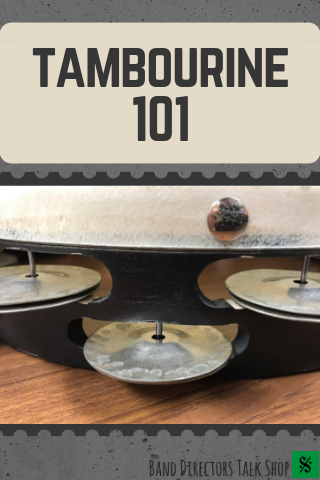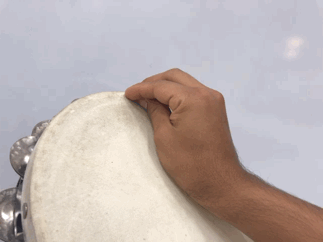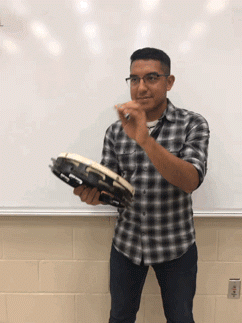https://banddirectorstalkshop.com/2019/01/07/tambourine-101/
Unfortunately, in the depths of preparing for a contest and various pieces, some of the auxiliary percussion gets pushed to the side. This places a mentality in the students that those instruments do not hold the same standard of playing or respect as we command from a trumpet or saxophone. This article is to help the director teach the detailed and imperative techniques in order for their students to successfully perform on the tambourine.

Playing Position
- Always stand with feet shoulder width apart. Let this be the non-negotiable standard for all percussion performance.
- Shoulders should remain relaxed.
- Holding the tambourine with the non-dominant hand will allow the player to execute all rhythms using their dominant hand. No need to switch for any type of playing.
- Fingers should wrap the rim and the thumb should be resting on top the head. The palm should be free from touching the rim.
- The hand executing rhythms should form the “birds beak” and will be played on the rim directly above the jingles for a quicker response.

Begin with both arms down to your side with your non-dominant hand holding the tambourine. Bending at the elbows bring the tambourine up to chest height. The dominant hand should set at about “chin height”. The tambourine should be set about 30 degrees above horizontal. The angle in which the tambourine is set will determine the amount of resonance from the jingles. The flatter the tambourine sets, the faster the decay of the jingles.
Playing Techniques
Indeed, the approach to holding and playing the tambourine simply depends on the dynamics and tempo of the rhythms you are playing. Based on the music given, you must decide the approach to take.
- Slow and Soft
- Slow and Loud
- Fast and Soft
- Fast and Loud
Slow and Soft
You can control the amount of sustain from the head by resting the bottom of your hand on the head while playing. For soft passages, you can also eliminate fingers used to play while still keeping your thumb behind the finger for support.


Slow and Loud
When the music calls for louder dynamics but still at a moderate tempo. For fortissimo and sforzando, you would need to “change your beating implement.” A fist in the center of the head will create the appropriate sound for louder dynamics as if “knocking on a door”. While striking the tambourine you will also use a rebound stroke for maximum resonance from the jingles and head.


Fast and Soft
You will need a chair or some stool to bring your knee closer to your playing position. Turn the
tambourine upside down so that the head is dampened against your knee. You will use your
fingers set directly above the jingles for quicker response (much like we always play directly
above the snare bed for the best response). For lesser dynamics, you can eliminate fingers for
softer playing.
tambourine upside down so that the head is dampened against your knee. You will use your
fingers set directly above the jingles for quicker response (much like we always play directly
above the snare bed for the best response). For lesser dynamics, you can eliminate fingers for
softer playing.



Fast and Loud
My favorite! Much like the implementing the fist for louder dynamics for the slow and loud
passages, we can also keep the tambourine resting on the knee and use two fists “knocking”
on the head. Lastly is the “fist/knee” technique. This is when we play fast passages while
striking the tambourine alternating between the fist and knee. The tambourine will mostly be
played with the knee but as sixteenth notes are added, the fist will play the “e’s” and the “ah’s”.
passages, we can also keep the tambourine resting on the knee and use two fists “knocking”
on the head. Lastly is the “fist/knee” technique. This is when we play fast passages while
striking the tambourine alternating between the fist and knee. The tambourine will mostly be
played with the knee but as sixteenth notes are added, the fist will play the “e’s” and the “ah’s”.

Shake Rolls
Every roll on every percussion instrument contains three parts. It starts with an attack, then sustain, and ends with a release. The most common roll on tambourine is performed with wrist rotation. Hold the tambourine vertically for the most resonance and sustain. Begin with rotating the wrist in then out on quarter notes. Once a full and consistence sound is established, gradually increase the tempo until a smooth roll is achieved. For the attack and release simply strike the tambourine according to the dynamic written, then release the same way. Placing the entire hand flat on the head will dampen any sustain if the music calls for a quick release. It is important to begin the shake roll with an attack and not the shake to prevent a sloppy jingle attack.


Types of Tambourines
Size:
- 10″ are the most common. Smaller sizes are also available.
Jingles:
- Bronze – darker sound
- Copper – medium sound
- Silver – brighter sound
- Mix – combinations of different timbres
Rows of Jingles:
- Single – dryer sound
- Double – richer lush sound (most common)
- Stacked vs. Staggered – Staggered rows of jingles will increase jingle response when playing directly above the rim.